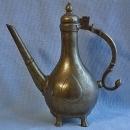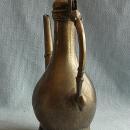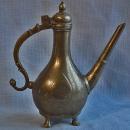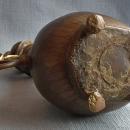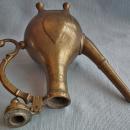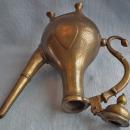Antique Mughal Northern Indian Islamic Brass Ewer Aftaba 18th Century India







$780.00
Or Best OfferThis is an exquisite and rare antique 18th-century Mughal Northern Indian Islamic cast brass lidded ewer or aftaba that is a true masterpiece of craftsmanship. The pear-shaped body of the ewer stands on four short feet, giving it a sturdy base and a regal appearance. The body is adorned with slightly raised almond-shaped medallions meticulously engraved with poppies, adding a touch of elegance and sophistication to the overall design.
The body of the ewer is also incised with intricate and beautiful floral and leaf motifs. Attention to detail is evident in every aspect of the ewer, from the delicate floral designs to the perfectly cast rib on the straight rising, tapering spout. The serpentine handle is a work of art, with a stylized lotus finial that adds a layer of beauty and complexity to the ewer.
The handle joins the neck and is hinged to the domed lid, a testament to the skill of the artisans who created this magnificent piece. The lid fits perfectly on the ewer, creating a seamless and harmonious design that is both functional and visually stunning.
This antique ewer is a true treasure that speaks to the rich cultural heritage of India and the Islamic world. It is a testament to traditional craftsmanship's beauty and timeless design's enduring appeal.
CONDITION: It is in excellent condition, showing its age and usage. It is worth noting that there are no visible repairs, splits, or dents on the item, which is a testament to the quality of its craftsmanship.
MEASUREMENTS:
Height: 25.4 cm (10 inches).
Width: handle to spout: 24.5 cm (9 5/8 inches).
REFERENCES: On page 165 of Zebrowski's book "Gold, Silver, and Bronze from Mughal India," there is a depiction of an ewer that bears a striking resemblance to the one in question. The book analyzes the metals used in Mughal India and the intricate designs often incorporated into their art. The similarity between the two ewers suggests that they may have been created by the same artist or during the same period, further highlighting the artistic and cultural significance of the piece.
